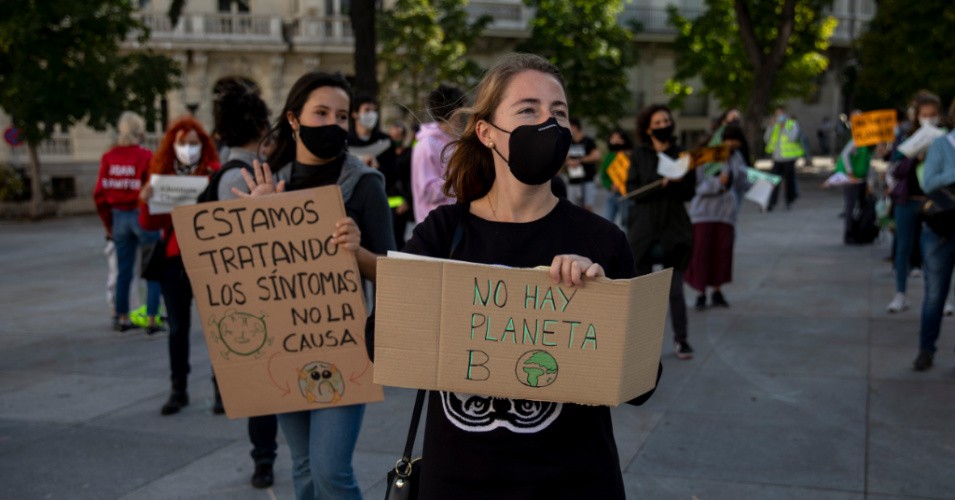‘We Have to Act’: Atmospheric CO2 Passes 420 PPM for First Time Ever in Recorded History
ENVIRONMENT, 12 Apr 2021
Kenny Stancil | Common Dreams - TRANSCEND Media Service
Carbon dioxide isn’t the only greenhouse gas scientists are concerned about. Emissions of methane and sulfur hexafluoride have also spiked to “worrying levels.”
6 Apr 2021 – The concentration of atmospheric carbon dioxide surged past 420 parts per million for the first time in recorded history this past weekend, according to a measurement taken at the Mauna Loa Observatory on the Big Island of Hawaii.
When the National Oceanic and Atmospheric Administration (NOAA) research station “began collecting CO2 measurements in the late 1950s, atmospheric CO2 concentration sat at around 315 PPM,” the Washington Post reported. “On Saturday, the daily average was pegged at 421.21 PPM—the first time in human history that number has been so high.”
Climate activist Greta Thunberg took notice of NOAA’s most recent data on CO2 levels. She described the first-ever documented eclipse of 420 PPM of CO2 in Earth’s atmosphere as “truly groundbreaking.”
🏆📈🏆 421.21 ppm #CO2 in Earth’s atmosphere on April 3, 2021 🏆 HIGHEST EVER daily average at the Mauna Loa Observatory & 1st time > 420 ppm 🏆 Up from 415.60 ppm a year ago 🏆 #NOAA source: https://t.co/MZIEphYygh 🏆 https://t.co/DpFGQoYEwb records: https://t.co/YU3HoKfp4a pic.twitter.com/xAKttc0rfS
— CO2_Earth (@CO2_earth) April 5, 2021
Exceeding 420 PPM of the heat-trapping gas “is a disconcerting milestone in the human-induced warming of the planet, around the halfway point on our path toward doubling preindustrial CO2 levels,” the Post noted, adding:
There is special significance in reaching and surpassing a concentration of 416 PPM. It means we’ve passed the midpoint between preindustrial CO2 levels, around 278 PPM, and a doubling of that figure, or 556 PPM.
The record of 421 PPM reached Saturday is just a single point and occurred as CO2 levels are nearing their yearly peak. But the levels over the past two months, of more than 417 PPM, signal that the annual average concentration is likely to exceed 416 PPM.

Activists hold signs reading “We Are Treating the Symptoms, Not the Cause” and “There Is No Planet B” during a climate justice demonstration outside the Spanish Parliament on September 25, 2020 in Madrid.
(Photo: Pablo Blazquez Dominguez via Getty Images)
While the growing concentration of atmospheric CO2—which increases the global average temperature and the number and severity of extreme weather events—is a long-term trend that corresponds with the rise of fossil fuel-powered capitalism, it has accelerated particularly rapidly since the 1970s.
CO2 concentration at the Mauna Loa Observatory reached a daily record of 421.21 Parts Per Million (PPM) on April 3. This is the first time in the recent measured record that PPM has topped 420 PPM. This map shows peak PPM values per year dating to the 1970s. Notice a trend? pic.twitter.com/K0Ioksncfb
— Steve Bowen (@SteveBowenWx) April 5, 2021
The doubling of atmospheric CO2 is expected to increase Earth’s temperature by 2.6 to 4.1ºC above preindustrial averages, a level of planetary heating that would “rul[e] out more modest warming scenarios,” as the Post noted.
“Even if greenhouse gas (GHG) emissions were to plummet overnight, the planet would continue warming for years to come,” the Post added. That’s because, as Zeke Hausfather, a climate scientist at the Breakthrough Institute in California, told the newspaper: “The amount of warming that the world is experiencing is a result of all of our emissions since the industrial revolution—not just our emissions in the last year.”
As the Post reported, CO2 isn’t the only GHG with “worrying trends.” Emissions of methane and sulfur hexafluoride have spiked, too.
Although methane doesn’t remain in the atmosphere as long as CO2, it absorbs heat much more effectively, which means that it greatly exacerbates the climate crisis. According to the Environmental Defense Fund, methane is 84 times more potent than CO2 in the first two decades after its release.
Here’s the Post on sulfur hexafluoride, a GHG that “results from the production of insulators used on electrical grids [and] also reached all-time records of 10 parts per trillion”:
While its concentration remains orders of magnitude more dilute than that of most other major greenhouse gases, its rate of increase in the atmosphere has doubled since 2003.
Sulfur hexafluoride is also thousands of times more potent—a single molecule can cause 23,900 times more warming than a molecule of CO2. And a single molecule of sulfur hexafluoride can stick around in the atmosphere for more than three millennia.
While the Paris climate agreement seeks to limit the rise in annual mean global temperature to 1.5°C above preindustrial averages by the end of the 21st century, the World Meteorological Organization warned last year that there is a 20% chance the world will hit or surpass that level of warming in at least one year by 2024.
“The science is clear,” United Nations Secretary-General António Guterres said in December. “Unless the world cuts fossil fuel production by 6% every year between now and 2030, things will get worse. Much worse.”
As forest ecologist Giorgio Matteucci tweeted Monday, “We have to act!”
_______________________________________________
Our work is licensed under a Creative Commons Attribution-Share Alike 3.0 License. Feel free to republish and share widely.
Tags: Climate Change, Earth, Environment, Global warming, Greenhouse Gases, History, Methane, Nature, Nature's Rights, Pollution, Science, Sulfur, Survival, United Nations
DISCLAIMER: The statements, views and opinions expressed in pieces republished here are solely those of the authors and do not necessarily represent those of TMS. In accordance with title 17 U.S.C. section 107, this material is distributed without profit to those who have expressed a prior interest in receiving the included information for research and educational purposes. TMS has no affiliation whatsoever with the originator of this article nor is TMS endorsed or sponsored by the originator. “GO TO ORIGINAL” links are provided as a convenience to our readers and allow for verification of authenticity. However, as originating pages are often updated by their originating host sites, the versions posted may not match the versions our readers view when clicking the “GO TO ORIGINAL” links. This site contains copyrighted material the use of which has not always been specifically authorized by the copyright owner. We are making such material available in our efforts to advance understanding of environmental, political, human rights, economic, democracy, scientific, and social justice issues, etc. We believe this constitutes a ‘fair use’ of any such copyrighted material as provided for in section 107 of the US Copyright Law. In accordance with Title 17 U.S.C. Section 107, the material on this site is distributed without profit to those who have expressed a prior interest in receiving the included information for research and educational purposes. For more information go to: http://www.law.cornell.edu/uscode/17/107.shtml. If you wish to use copyrighted material from this site for purposes of your own that go beyond ‘fair use’, you must obtain permission from the copyright owner.
